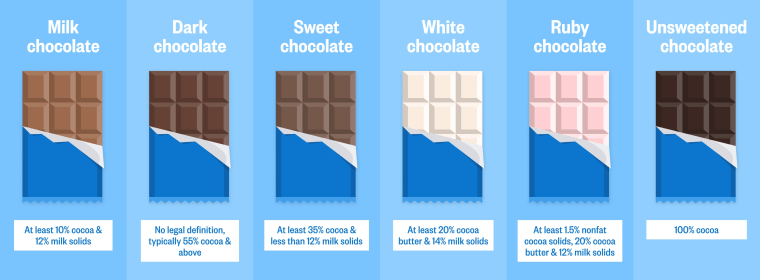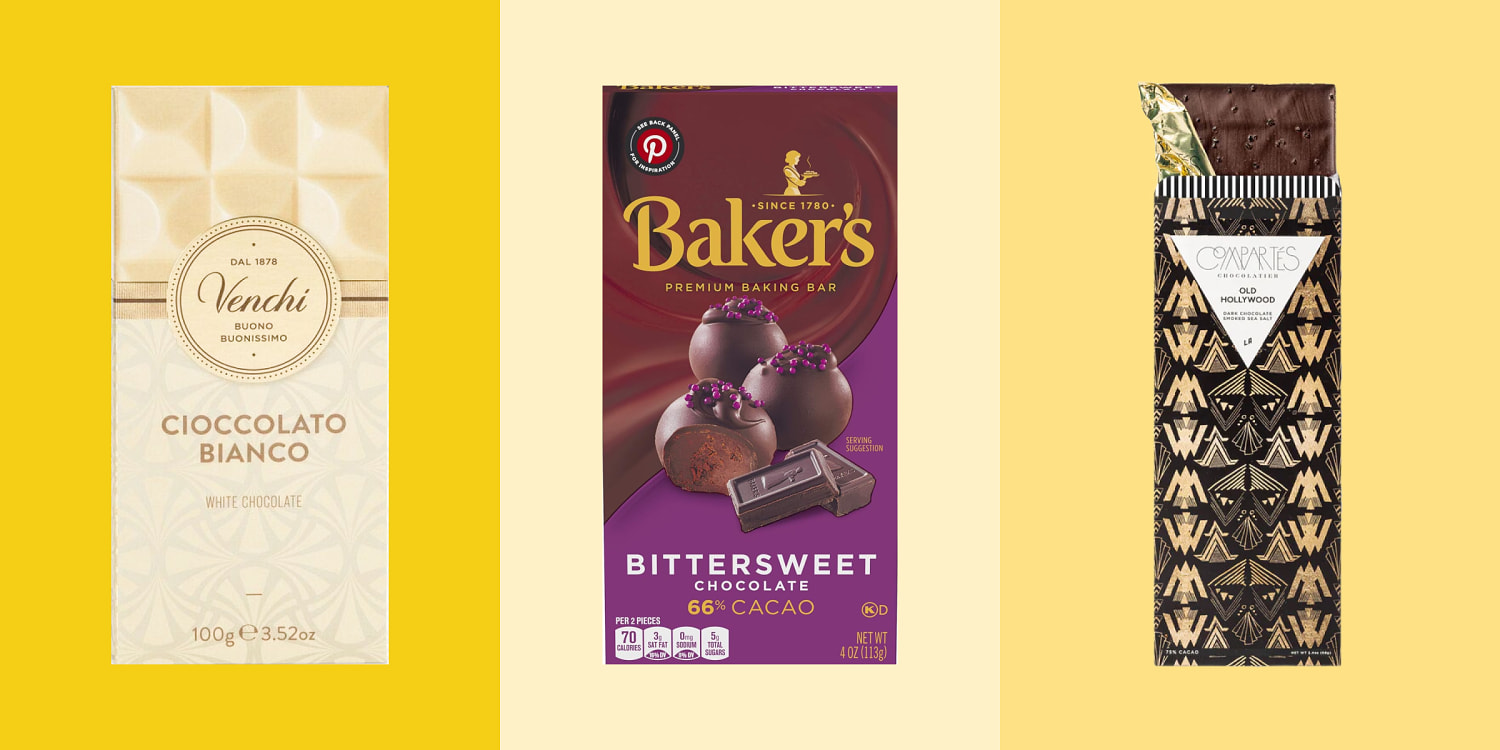If you close your eyes and imagine it, you can probably taste your favorite chocolate. Maybe it’s a bitter, chewy truffle with sea salt flakes on top, or a creamy, sweet bar that melts in your mouth when you break off a square. The beauty of chocolate is that each type has a unique flavor profile that culminates from where it’s harvested, how it’s processed and what ingredients are inside it. “A symphony of factors make each chocolate experience a deliciously distinct one,” says Jonathan Grahm, the head chocolatier, creative director and CEO of Compartés Chocolates.
Whether you’re buying chocolate for yourself or as a gift, knowing about different types makes you a smarter shopper, and may even encourage you to try something new in the kitchen. After all, not everybody has the same taste buds, and what you love about a certain chocolate may be the exact reason someone else dislikes it, says Jürgen David, the director of pastry research and development at the Institute of Culinary Education. We spoke to experts to learn more about how to shop for chocolate and how each type is made.
SKIP AHEAD Milk chocolate | Dark chocolate | What is bittersweet and semisweet chocolate? | Is white chocolate really chocolate? | Ruby chocolate | Unsweetened chocolate
What to know before shopping for chocolate
Before shopping, it’s important to learn about some of the key ingredients chocolate’s made from since different types are defined by specific ingredient ratios. Cacao percentage is also crucial to know heading into your local grocery store or online retailer since it greatly impacts chocolate’s flavor profile. Below, we outlined a few key definitions you’ll want to know prior to shopping.
The best types of chocolate for eating, baking and more
The best type of chocolate to eat and incorporate into recipes is the one that aligns with your flavor preferences. Our experts recommend trying a handful of varieties to narrow down your favorites, and say you should start by learning how each is defined to understand what makes them distinct. Below is everything you need to know about milk, dark and white chocolate, plus other common varieties. For each type of chocolate, we rounded up options you can shop from some of our favorite brands, plus other highly rated options. (The inclusion of Compartés chocolate in this story was made independently of our experts, including Grahm, who we only spoke to for guidance and general education.)

Milk chocolate
Milk chocolate has to be made from at least 10% cocoa (meaning the liquor, solids and/or butter mixture defined above) and at least 12% milk solids, according to the FDA. Since it has a lower cocoa content and a higher sugar content compared to dark chocolate, milk chocolate offers a sweeter taste, says David. The type of milk this chocolate is made with is up to a manufacturer’s discretion, which is why you might see some labeled “vegan” or “nondairy.” In recent years, more companies are making milk chocolate with almond milk, oat milk and coconut milk, giving customers the creamy, sweet flavor of milk chocolate without any of the dairy it’s typically associated with.
Dark chocolate
Compared to milk and white chocolate, dark chocolate has the highest percentage of cocoa solids and lowest percentage of additional ingredients like sugar, milk, cocoa butter, vanilla and emulsifiers, says Grahm. Because dark chocolate is mostly pure cocoa, some people say it’s a “healthier” type of chocolate, especially those looking to avoid sugar. Dark chocolate is often vegan, too, thanks to the lack of milk.
There’s no legal definition for dark chocolate from the FDA, but any chocolate that’s 55% cocoa or higher is typically labeled dark, says Grahm. The highest quality options are made with very few ingredients and usually have 75%, 85% or 90% cocoa, he says, but the higher the cacao content, the more bitter the chocolate is. Adults are often more likely to gravitate toward dark chocolate for this reason, says David. “As we age, our palate changes,” he says. “And as people get older, I’ve found that they tend to like the more intense, darker side of things instead of sweet and milky.”
Grahm particularly likes to use it for covering fruit — dark chocolate’s rich flavor balances out fruit’s inherent sweetness, he says. He also frequently uses dark chocolate to balance out the intensity of caramel’s sweetness.
What is bittersweet and semisweet chocolate?
Technically, bittersweet and semisweet chocolate are the same thing. They’re categorized by the FDA under the umbrella of sweet chocolate, and any chocolate labeled “sweet,” “bittersweet” or “semisweet” must have at least 35% cocoa and less than 12% milk solids, according to the agency. This means bittersweet and semisweet chocolate are types of dark chocolate — by definition, they can’t be milk chocolate since milk chocolate has to have at least 12% milk solids.
You’ll most often see chocolate labeled semisweet when it has a cocoa content closer to 60%, and chocolate labeled bittersweet when it has a cocoa content closer to 70%, says David. Thus, bittersweet chocolate is made with a bit more cacao and a bit less sugar, giving it a more intense flavor. But overall, as long as the chocolate meets FDA guidelines, whether it’s labeled “sweet,” “bittersweet” or “semisweet” is ultimately up to the manufacturer.
Is white chocolate really chocolate?
Yes, white chocolate is really chocolate, but it deviates from traditional milk and dark varieties since it’s not made with any cocoa solids whatsoever, says Grahm. White chocolate must have at least 20% cacao fat, otherwise known as cocoa butter, and at least 14% milk solids, according to the FDA. So overall, since it’s made with cocoa butter, and cocoa butter comes from cocoa beans, white chocolate is a type of chocolate.
Because cocoa solids are absent from white chocolate, it’s white in color and light in flavor, allowing additional ingredients to stand out better, like strawberries, matcha and spices that are incorporated into white chocolate bars or little confections, says Grahm. He sees white chocolate as a blank canvas of sorts for this reason. It also typically has a high sugar content, making it very sweet.
Ruby chocolate
Ruby chocolate is made from Ruby Cacao Beans, which come from specific regions like Brazil, Ecuador and West Africa’s Ivory Coast. It’s a relatively recent addition to the chocolate spectrum and was first brought to market in 2017 by Barry Callebaut, a Belgian-Swiss cocoa company that’s the main purveyor of ruby chocolate along with Chocolove.
Thanks to its unique taste, ruby chocolate is a distinct category within the chocolate family, says Grahm. “Its flavor profile is characterized by a yogurt-like essence, coupled with distinct fruity notes, setting it apart from the more conventional chocolate varieties,” he says. Ruby chocolate is naturally pink in color and must contain at least 1.5% nonfat cocoa solids, at least 20% cacao fat (cocoa butter) and at least 12% milk solids, according to the FDA.
Unsweetened chocolate
Unsweetened chocolate has a cacao content of 100%, meaning it’s entirely made up of components from the cocoa bean. It doesn’t have any sugar, emulsifiers, milk or other ingredients, and it’s great to bake with because it does not add any additional sweetness to cookies, cakes or other desserts.
Meet our experts
At NBC Select, we work with experts who have specialized knowledge and authority based on relevant training and/or experience. We also take steps to ensure that all expert advice and recommendations are made independently and with no undisclosed financial conflicts of interest.
Why trust NBC Select?
Zoe Malin is an associate updates editor at NBC Select who covers the food and beverage space, including stories on salt, olive oil, honey, nonalcoholic wine, nonalcoholic spirits and coffee subscriptions. For this article, she interviewed two experts about different types of chocolate and rounded up highly rated options and NBC Select staff recommendations.
Catch up on NBC Select’s in-depth coverage of personal finance, tech and tools, wellness and more, and follow us on Facebook, Instagram, Twitter and TikTok to stay up to date.
Source: | This article originally belongs to Nbcnews.com










